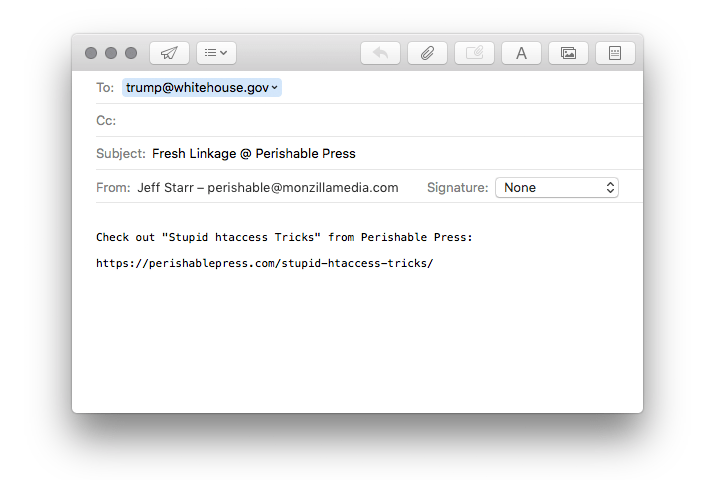Like most sites on the Web, Perishable Press is scanned constantly by malicious scripts looking for vulnerabilities and exploit opportunities. There is no end to the type and variety of malicious URL requests. It all depends on the script, the target, and the goal of the attack. Malicious scripts generally seek one of two things: Continue reading »
Rambling introduction. While setting things up here at Perishable Press with a second installation of WordPress, I’m trying to keep the number of custom functions and plugins down to a minimum. Seriously, if some feature or function is not absolutely necessary, then it gets kicked to the curb, as they say. So far, I’m using only the following plugins for the second WordPress installation: Continue reading »
![[ Screenshot: User Data in CSV Format ]](https://perishablepress.com/wp/wp-content/images/2010/misc-chunks/csv-user-data-example.gif)
I recently did some time in Microsoft Excel, preparing large CSV files for import into WordPress. Each of these CSV files contained data for 1000 WordPress users. Here is a screenshot showing the structure of the file: Conceptually, the idea is simple: import the data to create actual users for a WordPress-powered site. The trick is to clean the data as much as possible to ensure valid username and password information. Once the data is good, importing is easy using […] Continue reading »
![[ 2010 User-Agent Blacklist ]](https://perishablepress.com/wp/wp-content/images/2010/misc-chunks/user-agent-blacklist.png)
The 2010 User-Agent Blacklist blocks hundreds of bad bots while ensuring open-access for the major search engines: Google, Bing, Ask, Yahoo, et al. Blocking bad user-agents is an effective addition to any security strategy. It works like this: your site is getting hammered by rogue bots that waste valuable server resources and bandwidth. So you grab a copy of the 2010 UA Blacklist from Perishable Press, include it in your site’s root .htaccess file, and enjoy better security and performance. […] Continue reading »

Awhile ago, Silvan Mühlemann conducted a 1.5 year experiment whereby different approaches to email obfuscation were tested for effectiveness. Nine different methods were implemented, with each test account receiving anywhere from 1800 to zero spam emails. Here is an excerpt from the article: When displaying an e-mail address on a website you obviously want to obfuscate it to avoid it getting harvested by spammers. But which obfuscation method is the best one? I drove a test to find out. After […] Continue reading »
![[ Black Hole (Vector) ]](https://perishablepress.com/wp/wp-content/images/2010/blackhole/blackhole-01.jpg)
One of my favorite security measures here at Perishable Press is the site’s virtual Blackhole trap for bad bots. The concept is simple: include a hidden link to a robots.txt-forbidden directory somewhere on your pages. Bots that ignore or disobey your robots rules will crawl the link and fall into the honeypot trap, which then performs a WHOIS Lookup and records the event in the blackhole data file. Once added to the blacklist data file, bad bots immediately are denied […] Continue reading »
Over the course of each year, I blacklist a considerable number of individual IP addresses. Every day, Perishable Press is hit with countless numbers of spammers, scrapers, crackers and all sorts of other hapless turds. Weekly examinations of my site’s error logs enable me to filter through the chaff and cherry-pick only the most heinous, nefarious attackers for blacklisting. Minor offenses are generally dismissed, but the evil bastards that insist on wasting resources running redundant automated scripts are immediately investigated […] Continue reading »
![[ WordPress ]](https://perishablepress.com/wp/wp-content/images/2009/misc-chunks/wordpress-logo-blue.png)
One of the most popular articles here at Perishable Press is my January 2005 post, Stupid htaccess Tricks. In that article, I bring together an extensive collection of awesome copy-&-paste HTAccess code snippets. Four years later, people continue to tell me how much they enjoy and use the content as a bookmarked reference for many of their HTAccess needs. The article was even published in a book on Joomla! Security. This is very inspiring to me, so I have decided […] Continue reading »
When developing the colorful Quintessential Theme (opens in new tab), I initially planned on displaying five random posts from each of my most popular tags and categories in the super-slick sliding-panel sidebar. Because I am running an older version of WordPress, however, this task proved to be quite the educational experience. In newer versions (from 2.5 I think) of WordPress, the query_posts() function enables users to display posts in random order using the orderby=rand parameter. This would have made my […] Continue reading »
I finally broke down and uninstalled Alex King’s once-great “Popularity Contest” plugin for WordPress. The plugin had been active here at Perishable Press for over two years, and had provided fairly consistent and apparently accurate statistics while in service. Unfortunately, there were serious errors involved with the plugin way back during the WordPress-2.3 upgrade that were never addressed by the plugin author. There was an interim version of the plugin that had patched the error until an official update was […] Continue reading »
Given my propensity to discuss matters involving error log data (e.g., monitoring malicious behavior, setting up error logs, and creating extensive blacklists), I am often asked about the best way to go about monitoring 404 and other types of server errors. While I consider myself to be a novice in this arena (there are far brighter people with much greater experience), I do spend a lot of time digging through log entries and analyzing data. So, when asked recently about […] Continue reading »
Importing and displaying external RSS feeds on your site is a great way to share your online activity with your visitors. If you are active on Flickr, Delicious, Twitter, or Tumblr, your visitors will enjoy staying current with your updates. Many social media sites provide exclusive feeds for user-generated content that may be imported and displayed on virtually any web page. In this article, you will learn three ways to import and display feed content on your WordPress-powered website — […] Continue reading »
You have seen user-agent blacklists, IP blacklists, 4G Blacklists, and everything in between. Now, in this article, for your sheer and utter amusement, I present a collection of over 8000 blacklisted referrers. Shortcut: skip the article and jump to Disclaimer and Download » Referrer Spam Sucks For the uninitiated, in teh language of teh Web, a referrer is the online resource from whence a visitor happened to arrive at your site. For example, if Johnny the Wonder Parrot was visiting the […] Continue reading »

In addition to your choice collection of “Share This” links, you may also want to provide visitors with a link that enables them to quickly and easily send the URL permalink of any post to their friends via email. This is a great way to increase your readership and further your influence. Just copy & paste the following code into the desired location in your page template: <a href="mailto:?subject=Fresh%20Linkage%20@%20Perishable%20Press&body=Check%20out%20<?php the_permalink(); ?>%20from%20Perishable%20Press" title="Send a link to this post via email" rel="nofollow">Share […] Continue reading »
![[ Image: Inverted Eclipse ]](https://perishablepress.com/wp/wp-content/images/2009/agent-blacklist/inverted-eclipse.jpg)
As discussed in my recent article, Eight Ways to Blacklist with Apache’s mod_rewrite, one method of stopping spammers, scrapers, email harvesters, and malicious bots is to blacklist their associated user agents. Apache enables us to target bad user agents by testing the user-agent string against a predefined blacklist of unwanted visitors. Any bot identifying itself as one of the blacklisted agents is immediately and quietly denied access. While this certainly isn’t the most effective method of securing your site against […] Continue reading »
![[ 4G Stormtrooper ]](https://perishablepress.com/wp/wp-content/images/2009/misc-chunks/stormtrooper-4g.jpg)
At last! After many months of collecting data, crafting directives, and testing results, I am thrilled to announce the release of the 4G Blacklist! The 4G Blacklist is a next-generation protective firewall that secures your site against a wide range of automated attacks and other malicious activity. Continue reading »

![[ Screenshot: User Data in CSV Format ]](https://perishablepress.com/wp/wp-content/images/2010/misc-chunks/csv-user-data-example.gif)
![[ 2010 User-Agent Blacklist ]](https://perishablepress.com/wp/wp-content/images/2010/misc-chunks/user-agent-blacklist.png)

![[ Black Hole (Vector) ]](https://perishablepress.com/wp/wp-content/images/2010/blackhole/blackhole-01.jpg)
![[ WordPress ]](https://perishablepress.com/wp/wp-content/images/2009/misc-chunks/wordpress-logo-blue.png)

![[ Image: Inverted Eclipse ]](https://perishablepress.com/wp/wp-content/images/2009/agent-blacklist/inverted-eclipse.jpg)
![[ 4G Stormtrooper ]](https://perishablepress.com/wp/wp-content/images/2009/misc-chunks/stormtrooper-4g.jpg)
